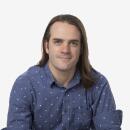‘Shut it down!’ How group chats, rumors and fear sparked a night of violence at UCLA
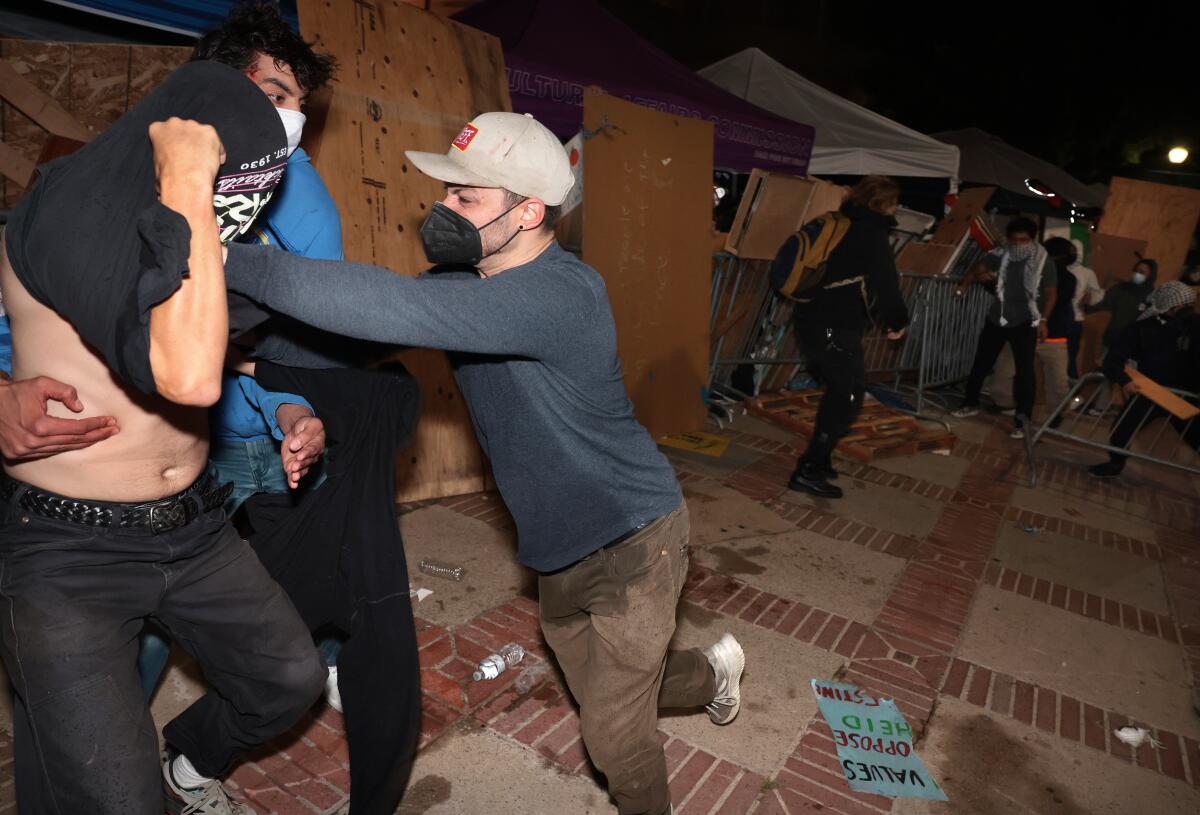
As violence began to flare at the barricades of the pro-Palestinian encampment at UCLA last week, Sean Tabibian trained his camera on the police.
“Shut this down,” implored the 52-year-old lawyer, who had returned to his alma mater after hearing on WhatsApp that Jewish students were being excluded from campus.
The crowd that descended on UCLA was inflamed by posts on social media and in private group chats that said Jewish students were being mistreated, blocked from parts of campus and even attacked.
Some of the most incendiary claims have not been verified, but as they ricocheted across group chats and were amplified online, a crowd converged on UCLA the night of April 30. Some said they were there to protect Jewish students and ensure their access to school buildings. Others were intent on dismantling the encampment one way or the other.
“What are you waiting for?” Tabibian shouted at the police. “They have weapons in their encampment. … They have tear gas.”
“Do your job!” yelled another member of the crowd, adding an expletive, as a chant broke out: “Shut it down!”
Police ignored them. Four minutes after the officers arrived, Tabibian said, they did something that left him so stunned that all he could do was film it, repeating over and over: “This is unbelievable.”
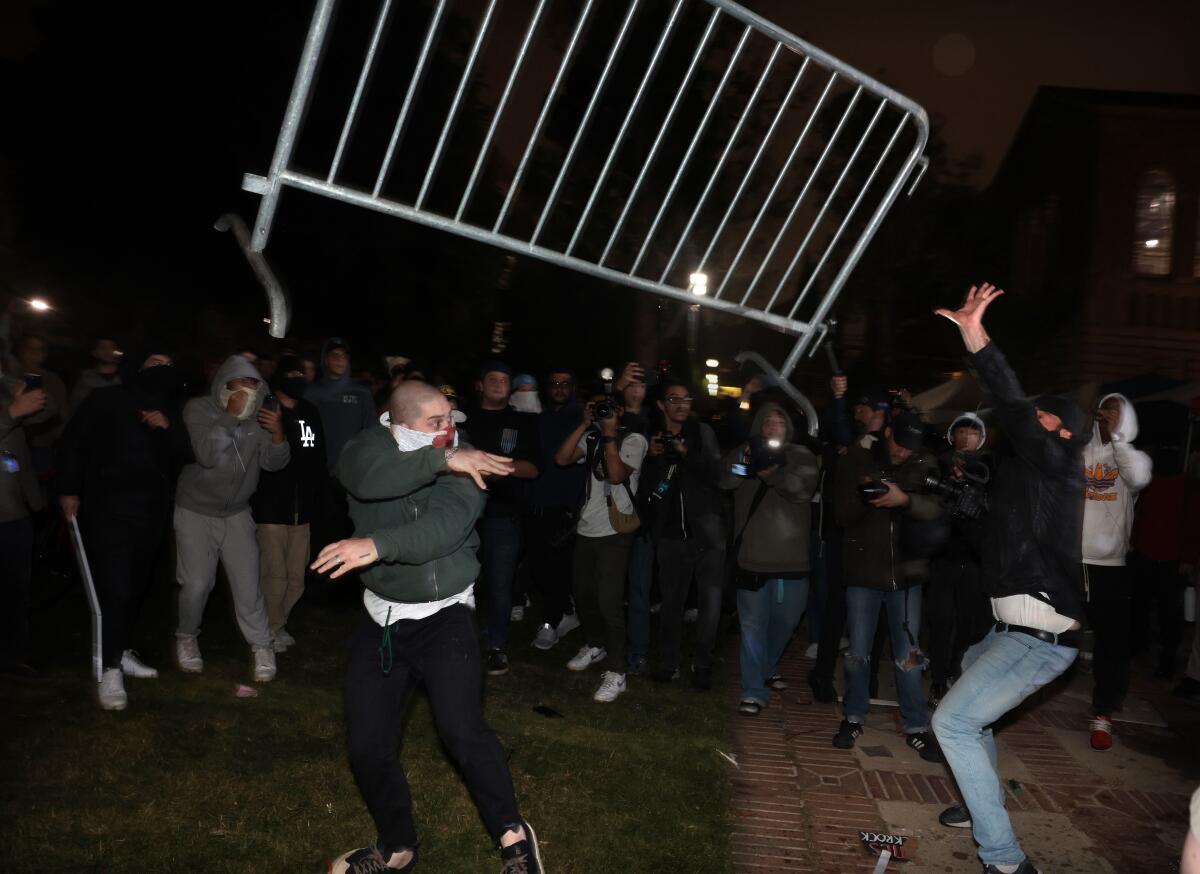
As a helicopter whirred overhead and masked men yelling pro-Israel slogans circled the camp’s plywood barricades, the officers drove away.
Moments later, a firework exploded in the no-man’s land between the pro-Israeli crowd and the barricades. Screams erupted as men wrestled a pipe from a masked protester who had emerged from the encampment.
A group of people wearing kaffiyehs hustled past the melee, carrying an injured person on a makeshift stretcher. One pro-Palestinian protester said it felt like “a war zone.”
Tabibian said he was disturbed by the violence and left campus as things got out of hand.
It was the beginning of hours of unchecked violence that left more than 30 protesters injured, according to the Council on American-Islamic Relations Los Angeles.
More than a week later, none of the aggressors has been arrested. Multiple law enforcement agencies have said they are investigating why UCLA took so long to quell the violence, while also using facial recognition, cellphone data analysis and other tools to try to identify the perpetrators. Online sleuths have attempted to do the same.
What exactly drove dozens of people to converge on UCLA and attack the encampment remains unclear. The Times did not speak to anyone who acknowledged taking part in the assault, but interviews, public records, videos and social media offer a window into the conditions that led up to it.
Los Angeles Mayor Karen Bass — who has compared the violence to the Jan. 6, 2021, attack on the U.S. Capitol — said it was unclear whether the violence at UCLA was coordinated, but that she didn’t believe people could just “wake up” and decide to commit unprovoked assaults.
Regardless of whether it was planned or random chaos, those affected by the attack remain shaken.
Kaia Shah, a 23-year-old UCLA graduate student, said she saw the pro-Israel protesters rip wooden planks from the barricades and use them to hit pro-Palestinian demonstrators. Shah said she was targeted with bear spray while others were punched in the face.
“It was violent and terrifying chaos for five hours,” she said.
By the time violence erupted at the fringes of the encampment the evening of April 30, tensions had been building for days — both online and on campus.
Rabbi Yossi Eilfort, a former MMA fighter, runs the nonprofit private security firm Magen Am, which provides protection to the Jewish community. He said he had coordinated with UCLA on April 28 to help ensure a counterprotest staged that day stayed peaceful — although some skirmishes did break out.
Between the counterprotest and the attack two days later, the rabbi said, his group received a flood of reports — spread on social media and shared in WhatsApp group chats — of students being denied entry to classrooms and some people being threatened with tasers and other weapons.
As he watched the videos and posts flash across his phone, Eilfort said, “I was thinking this is going to get really bad if it’s not handled.”
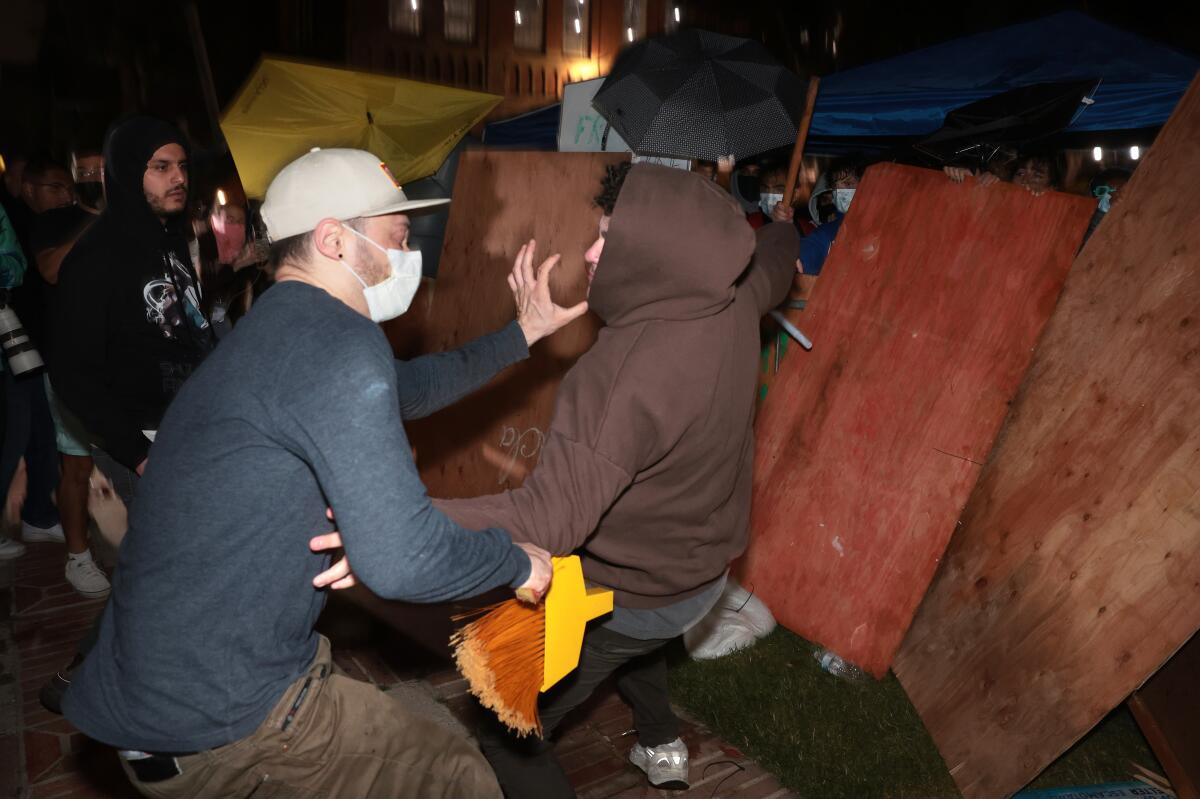
One flashpoint was a video that showed a woman collapsing amid a crowd of protesters. It was posted to Instagram on April 30. The caption read: “Jewish girl at UCLA was surrounded by five people wearing keffiyehs and bludgeoned in the head while they stomped on her Israeli flag. She lost consciousness and her body went limp. She was carried away then sent to the ER.” The woman told The Times she had been shoved to the ground by another demonstrator while attempting to retrieve her fallen flag.
One of those at UCLA on the Sunday preceding the riot was David Kaminsky, a 23-year-old boxer whose family runs a gym in Reseda. He described the event that drew him there as a pro-Israeli “festival” staged near the encampment; the pro-Palestinian contingent viewed it as a provocation and attempt to disrupt their protest.
Eilfort said the pro-Israel event was permitted, and blamed those in the encampment for coming into their space and causing problems. But a video that went viral on X also showed Kaminsky spitting at protesters and calling one the n-word.
Kaminsky admitted using the slur in an interview with The Times but said he didn’t say it with a “hard R” and that it was “slang in the boxing community.”
He said he was reacting to being spit on by protesters who told him, “Jews will burn and die,” and that he did not spit on anyone, only in their direction.
“I’m fine with people supporting Palestine. It’s a free country,” he said. But “don’t look at me and tell me that all Jews are going to die, that my whole family will burn and all this stuff. Because that’s that line that you cross.”
The gym’s Yelp account was inundated with negative and antisemitic reviews and was deactivated. Kaminsky shut down his Instagram page.
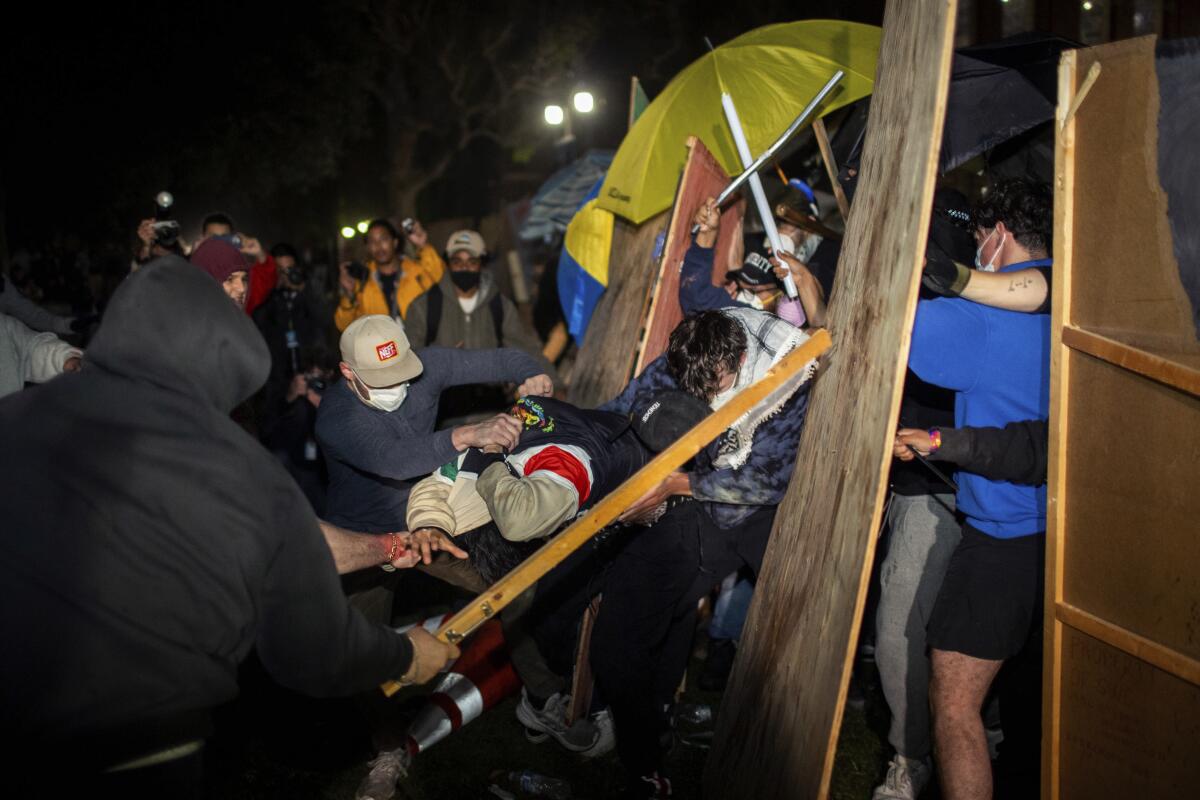
Kaminsky said he was outraged by a rumor he heard from friends and on social media about a Jewish girl at UCLA being pushed and spit on while walking to class. The Times could not confirm the incident.
Some social media posts have claimed Kaminsky was present at UCLA on the night of the riot, but he said he was at home smoking a cigar when it unfolded.
Tabibian was among those wading through the onslaught of social media around the campus protests.
On April 29, the lawyer was scrolling through a WhatsApp chat when he came across another widely shared recording. The Times reviewed the audio recording — a conversation between the mother of a UCLA student and a campus police dispatcher — and law enforcement sources confirmed its authenticity.
The mother said people in the encampment were not allowing her son into the library or his classroom because he was Jewish.
“That wasn’t a university thing,” the dispatcher explained. “That’s probably the protesters who are out there.”
When the mother asked whether the protesters are allowed to bar her son from campus buildings, the dispatcher said: “Unfortunately, they have kind of taken over that little area right there” — suggesting that maybe her son could find a different way in.
“With all due respect,” the mother asked, “why should a Jewish kid have to go to another entrance?”
The dispatcher sounded apologetic: “Unfortunately, the police are not intervening with that right now. This is coming from the university.”
Neither the woman nor the dispatcher was identified.
Tabibian, who first came across the recording in a 1,000-person chat called “Persian Jews of L.A.,” said it was also posted in such message threads as “United Jewish Coalition,” “Israelis of L.A.,” “Lawyers for Israel” and Beverly Hills neighborhood groups.
People exchanged messages in the chats saying they were shocked UCLA would allow such discrimination, Tabibian said. As a former student who attended the university’s film school in the 1990s, he decided the night of April 30 to see for himself what was going on.
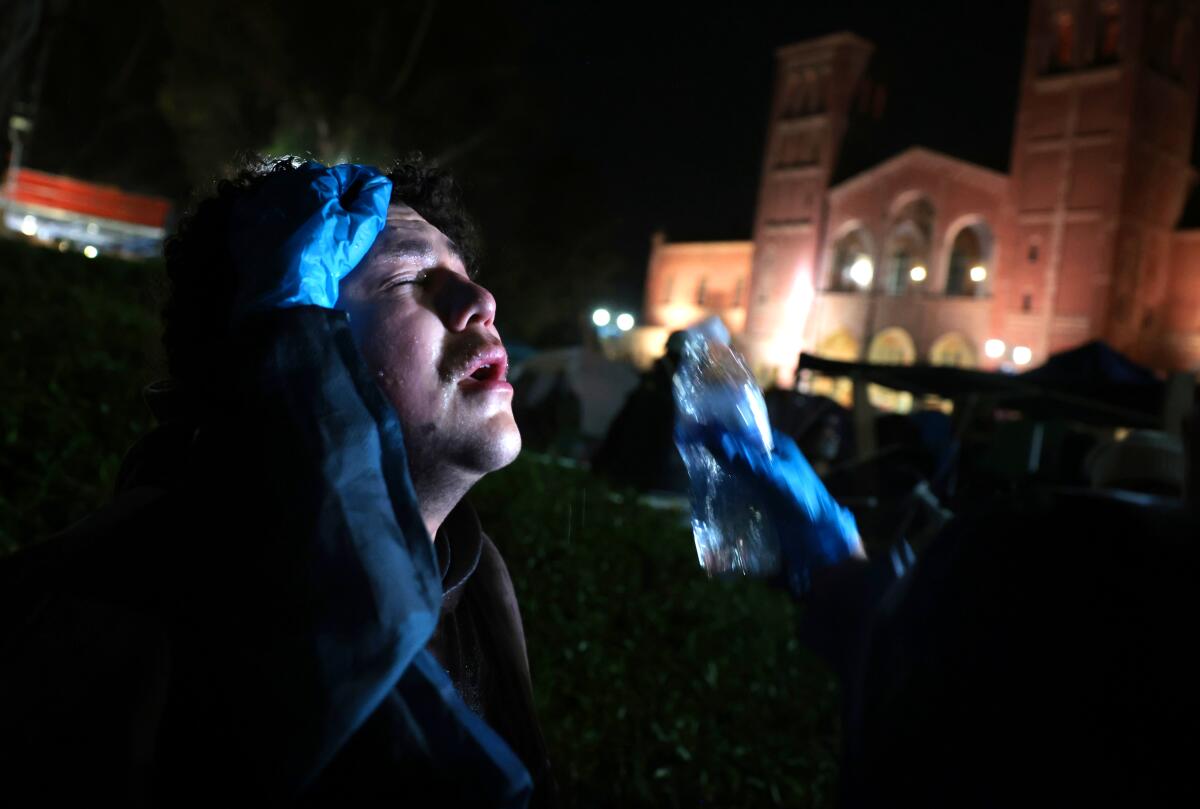
After making the short walk from his home to the campus, Tabibian said, he was rebuffed by around six self-appointed gatekeepers to the encampment who asked if he knew anyone inside.
“I don’t know, maybe,” he replied. According to Tabibian, they demanded he call someone inside the encampment on FaceTime as proof. When he refused, he said they blocked him from entering, telling him: “We’re not going to engage with you.”
Outside the barricades, Tabibian mingled with other counterprotesters whom he described as a “mixed bag of people”: Israelis, Persian Jews, UCLA students, their parents and alumni.
Lani Mekeel, 33, a former Los Angeles resident who now lives in Wisconsin, was back visiting during her fiance’s work trip. Mekeel said she’d heard about violence against Jewish students, and referenced a video of a girl who was attacked.
Mekeel, who described herself as Native American, came on April 30 with a sign that read: “Hamas supporters are not welcome on Native land.”
After exchanging words with the demonstrators, she and her friends left around 10:30 p.m. and as they were pulling into the parking lot, she saw two groups of about 15 to 20 men dressed in dark clothing. She didn’t know anyone who participated in the violence, she said.
“I feel as though our police departments, the school, the school security have consistently shown Jewish people and Jewish students that they do not care about their safety,” she said.
Some had come after watching a video filmed by a Jewish UCLA student, Eli Tsives, who posted what he characterized as a video of himself trying to walk through the encampment to get to class on April 29.
Tsives told the protesters they were blocking him from a building where he had class. Showing his UCLA ID to the camera, he said: “We pay tuition, this is our school, and they’re not letting me walk in. Just let me and my friend go into class.”
“You guys are promoting aggression, you guys are promoting hate,” Tsives told the protesters when they refused to let him through.
The following night, the mood among counterprotesters was light at first, Tabibian said. They traded taunts with people inside the encampment, he said, although he did see among the pro-Israel crowd a half-dozen men dressed in black, wearing black and white masks like something out of the movie “The Purge.”
They played an audio recording of an infant crying on a loop to keep protesters inside the encampment from sleeping, Tabibian said.
But after a while, some counterprotesters began prying at the barricades of plywood and metal fencing. In response, protesters inside the encampment struck their hands with sticks. Then someone unleashed pepper spray.
One UCLA undergraduate said she was sleeping in her tent in the encampment when she was woken up by the melee.
The 20-year-old, who asked not to be named because she feared retaliation from counterprotesters, rushed to the barricades, where she fought back until someone either threw or shot a powerful firework that blew up a couple of feet from her head. The shock of the blast knocked her unconscious, she said, and she woke up with a concussion and went to the hospital.
“I’m surprised no one died,” she said. “I was sitting in the hospital and the person to my right had pepper spray or tear gas all the way up in his lungs; he was coughing horribly. The person to my left, their hand had been disfigured by a hammer.”
Three students who had spent many hours at the encampment over the preceding days were working out at a university gym when they got an alarming message in a group chat for pro-Palestinian demonstrators: “Yo, you guys have to come now.”
As they rushed to the camp around 11 p.m., they encountered a group of Muslim women near a parking lot who said a friend had been pepper-sprayed, according to one of the students, who requested anonymity for fear of police reprisal.
As he and his friends neared the encampment, the student said, they came upon a woman in distress.
“Her hijab was off. Her eyes were bloodshot red. There were tears going down her cheeks. She was hunched over squealing,” he said. “That was a crazy thing to see. At that moment, I knew this was way different than all the other encounters.”
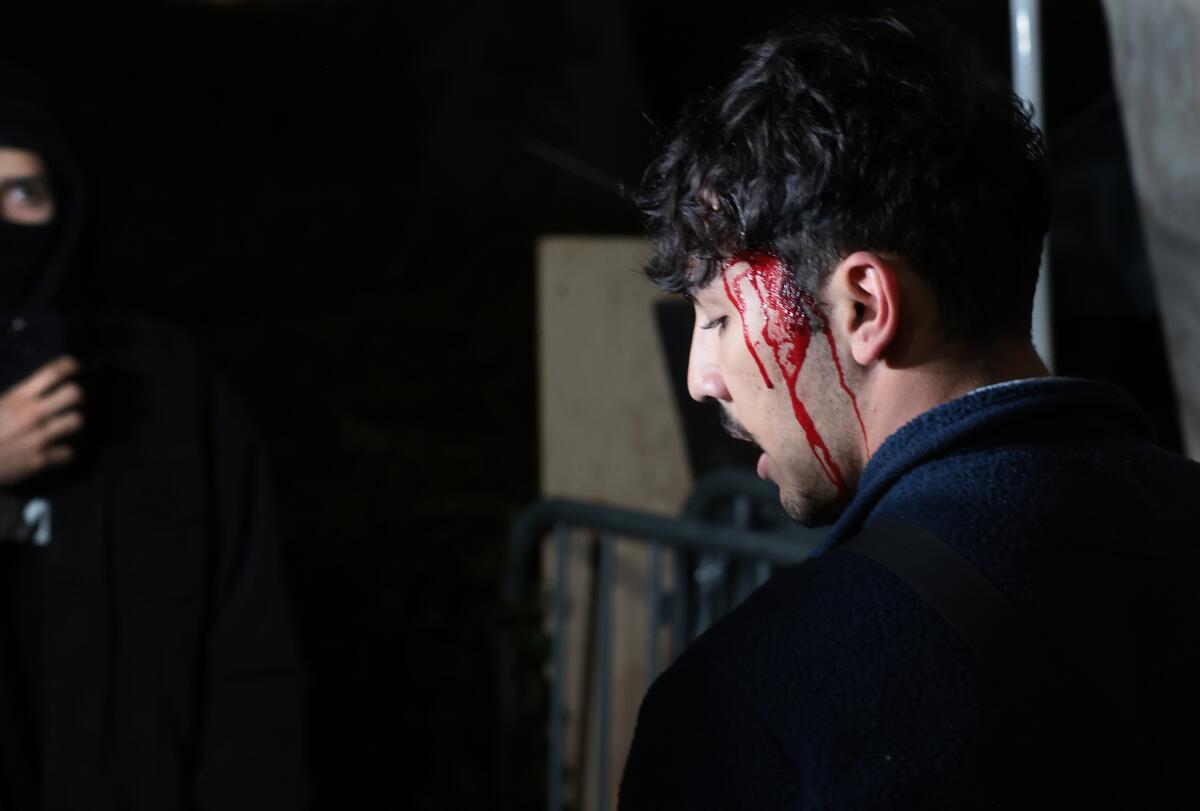
He headed to the front-line barricade, where his fellow protesters were facing off against what he called “the Zionists.” On his way there, he said, a firework nearly hit him and showered him with sparks.
“This was just straight chaos,” he said.
From the other side of the barricade, Tabibian made a similar assessment: “All hell broke loose.”
As the crowd tore down the wooden planks lining the barricade, about 30 security guards posted at the perimeter of the encampment “abandoned their posts,” Tabibian said.
Tabibian said he called the police at 11:09 p.m. and told a dispatcher people were being hurt. Six UCLA police cars and an ambulance showed up at 11:15 p.m., he said.
Tabibian said he was relieved to see the officers wearing helmets and holding batons, believing they would restore order. Instead, they stood beside their patrol cars as an EMT treated a person sprawled on a sidewalk, according to a video that Tabibian filmed of the incident.
And then, just four minutes after arriving, the police were gone, Tabibian said. “Why are they leaving?” Tabibian said as the squad cars drove off.
The violence continued for at least two more hours.
Times staff writer Richard Winton contributed to this report.
More to Read
Sign up for Essential California
The most important California stories and recommendations in your inbox every morning.
You may occasionally receive promotional content from the Los Angeles Times.



